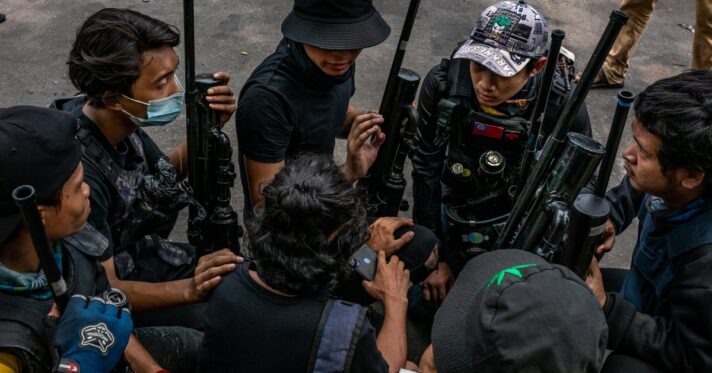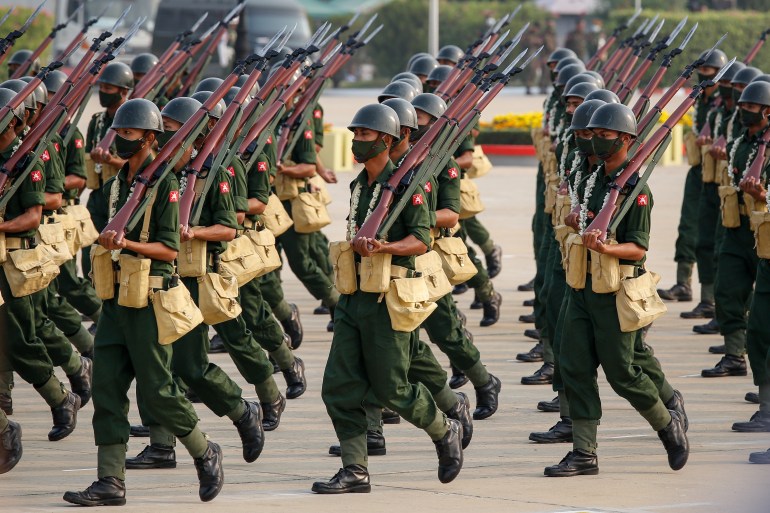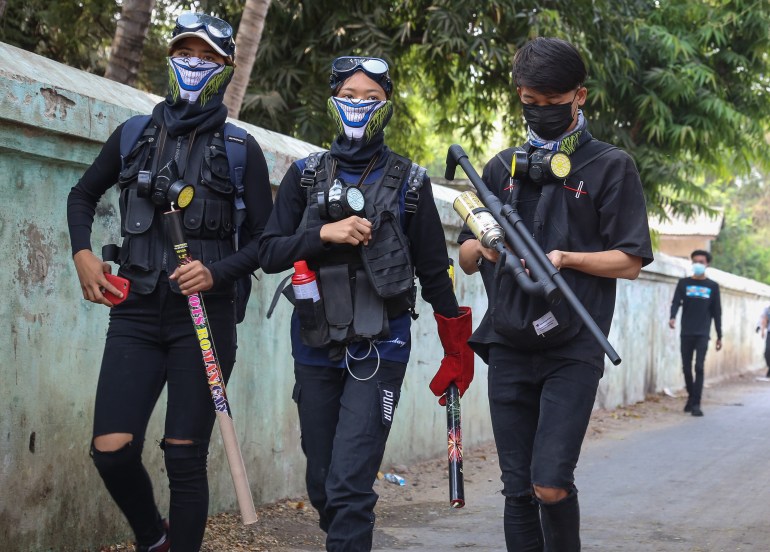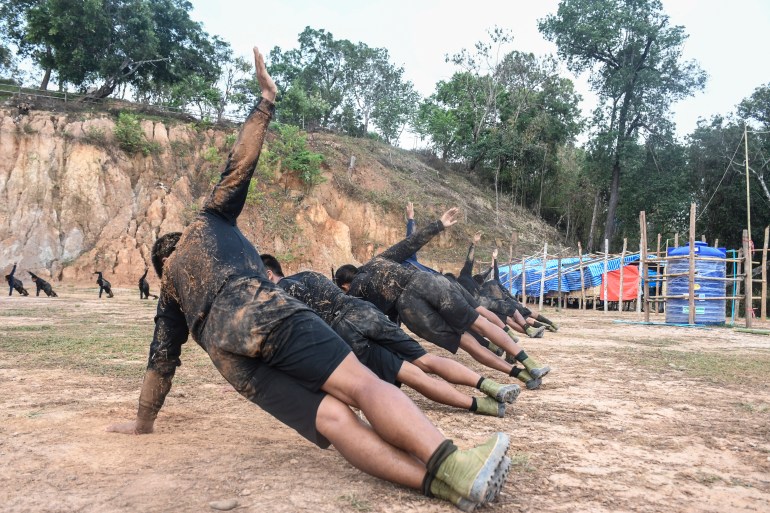
Civilian forces are training with ethnic armed groups and setting up cells in the cities, but face a formidably armed military.
In the weeks following the February 1 military coup, Andrew joined millions across Myanmar in peacefully demonstrating for a return to civilian rule.
Less than two months later, the 27-year-old was training to kill soldiers with a wooden hunting rifle in the jungles of his native Kayah State on Myanmar’s southeastern border with Thailand.
“Before the coup, I couldn’t even kill an animal,” said Andrew, who in common with other resistance fighters interviewed by Al Jazeera preferred his name not be disclosed for security reasons. “When I saw the military kill civilians, I felt really sad and troubled… I came to the mindset that I’m fighting for the people against evil military dictators.”
Andrew is among growing numbers of civilians across the country, many of them young, who have taken up arms to bring down a military that has killed more than 860 people, mostly in anti-coup protests, arrested more than 6,000, and used tactics including torture and enforced disappearances since it seized power from the elected government of Aung San Suu Kyi.
 Members of the Chinland Defence Force (CDF) armed group inspect weapons on a Myanmar army vehicle after they ambushed a convoy in western Myanmar’s Chin state
Members of the Chinland Defence Force (CDF) armed group inspect weapons on a Myanmar army vehicle after they ambushed a convoy in western Myanmar’s Chin state
Some of the fighters have enlisted in ethnic armed organisations in the country’s borderlands, where ethnic minorities have fought for decades against Myanmar’s military, the Tatmadaw, for self-determination and rights. Others, like Andrew, have joined one of several dozen civilian defence forces that have sprung up in cities and towns since late March.
But while ethnic armed groups have had years to develop resources and capacity, civilian defence forces are mostly armed with single-shot hunting rifles and other homemade weapons, and many fighters have had only a few weeks of combat training.
Facing a military that has amassed more than $2bn in arms and has 70 years of experience cracking down on civilian populations, the new revolutionaries told Al Jazeera they were willing to test the odds because they felt armed resistance was the only option left to bring down the regime.
“We have conducted nationwide protests and launched a civil disobedience movement against the military in hopes of restoring civilian democracy, but those methods alone didn’t work,” said Neino, a former university lecturer who is now leading the political arm of a civilian resistance group in Chin State and neighbouring Sagaing region. “We have done everything we can, and taking up arms is the only way left to win this,” she added.
Salai Vakok, a 23-year-old community development worker-turned-resistance fighter, also in Chin State, started collecting hunting rifles in his native Mindat township shortly after the Tatmadaw began gunning down protesters in mid-February.
“We used to hope that people from outside the country would fight for us, but that never happened,” he said.
“I never in my life thought I would hold a weapon… but I quickly changed my mind after learning about the killing of unarmed, innocent civilians across the country and especially in lowland areas. I couldn’t stay silent. To avenge the fallen heroes and show my solidarity, I decided to take up arms.”
The Tatmadaw has responded to armed resistance with indiscriminate air and ground attacks and by starving access to aid, food and supplies to civilian populations, following patterns of violence it has long executed in ethnic areas. Nearly 230,000 people have fled their homes since the coup; many hiding in the jungle.
In Kayah and neighbouring Shan State, where civilian fighters joined local ethnic armed groups to wage a 10-day resistance in late May during which they claim to have killed more than 120 regime forces, the Tatmadaw has gunned down humanitarian volunteers delivering food aid and has also shot dead displaced people returning into town to get rice and supplies. On May 24, regime forces fired artillery on a Catholic church where more than 300 people were taking shelter, killing four of them.
On June 9, a UN expert warned of “mass deaths from starvation, disease and exposure” in Kayah State after the Tatmadaw cut off access to food, water and medicine to more than 100,000 displaced civilians.
Salai Vakok’s Mindat township is also facing a rising humanitarian emergency after the Tatmadaw responded to civilian resistance in mid-May by launching attacks on residential areas and blocking the supply of food and water to displaced populations. It has also been accused of arresting civilians and using them as human shields to deter resistance fighters.
 The civilian resistance fighters face a formidably-armed military that has been accused of ‘crimes against humanity’ in its brutal attacks on the Rohingya in 2017
The civilian resistance fighters face a formidably-armed military that has been accused of ‘crimes against humanity’ in its brutal attacks on the Rohingya in 2017
He said the attacks have strengthened his resolve to keep fighting, but he has been unable to do so since he was injured by artillery fire in last month’s offensive. “When I recover, I have made a firm decision to keep fighting no matter what until the regime falls,” he told Al Jazeera.
Urban resistance appears to be growing as well, largely as a result of young people who have banded together in underground networks after attending short training camps with ethnic armed groups in the jungle. On returning to the cities, they adopt guerrilla tactics including bombings, arson and targeted killings, including people suspected of being informants or people aligned with the military.
Current affairs magazine Frontier Myanmar has reported that there are at least 10 urban rebel cells in Myanmar’s main cities, while Radio Free Asia has counted more than 300 explosions since the coup, mostly on police and administrative offices and other facilities connected to the regime.
“[The Tatmadaw] are oppressing us with guns. Should we kneel down or should we fight back? If we resist with only a three-finger salute, we will never get what we want,” said Gue Gue, a 29-year-old medical doctor and member of the underground resistance in Yangon. “We are not armed by choice; it is because we couldn’t get what we wanted by asking peacefully.”
But he said he is living in constant fear of informants. “We in urban areas have to live secretly or we could be killed…We cannot sleep soundly,” said Gue Gue.
Another concern for resistance fighters is their families: Since the coup, at least 76 people have been detained when security forces could not find the person they sought to arrest, according to a human rights documentation group.
“I told my parents that if the military searches for me, to say that they tried to convince me not to take up arms, but that I didn’t listen,” said Salai Vakok. He has cut contact with his family since he joined the resistance, but heard they are among thousands displaced by May’s clashes in Mindat and are now hiding in the jungle.
 Demonstrators in Mandalay armed with homemade weapons during a protest in April. More protesters are joining rebel forces because they see it as the only way to restore democracy
Demonstrators in Mandalay armed with homemade weapons during a protest in April. More protesters are joining rebel forces because they see it as the only way to restore democracy
The Committee Representing Pyidaungsu Hluttaw (CRPH), made up of elected lawmakers overthrown in the coup, announced on March 14 its support for civilians’ right to defend themselves, and on May 5, the CRPH-appointed National Unity Government (NUG) announced the establishment of a national-level People’s Defence Force, a precursor to a Federal Army which would unite the country’s ethnic armed groups and civilian defence forces under a central command.
At the moment, however, most of the groups are operating independently or in smaller alliances. Khu Te Bu, deputy minister of Home Affairs under the NUG, told Al Jazeera he expected fighting across the country to worsen in the coming weeks and months but worried that civilian defence forces were outgunned and lacked sufficient training to defeat the Tatmadaw.
“They are using handmade weapons, but they cannot protect the people against a military which has been preparing itself and building up its weapons supply for so many years,” he said.
On May 26, the NUG announced a code of conduct. Addressed to all armed resistance groups, it says fighters must avoid harming civilians and minimise collateral damage.
Khu Te Bu says he hopes that resistance groups can come together against a common enemy, and says the NUG has an important role to play in ensuring that the groups have a strong awareness of the rules of war, including how to protect civilians and handle prisoners of war.
 Some protesters have sought basic training with ethnic armed organisations that have spent years fighting the Tatmadaw
Some protesters have sought basic training with ethnic armed organisations that have spent years fighting the Tatmadaw
“Resistance groups cannot just break international rules because the military doesn’t follow them,” he said. “They have to respond to enemies systematically…to protect human rights.”
With weapons and funds in short supply, civilian fighters say they hope the NUG can also provide human resources and material support in the near future. “If they really want to help us, they can send fighters or provide us with modern weapons, or at least they can support us with food and commodities,” said Salai Vakok.
As the violence continues and deaths and displacement rise, resistance fighters also hope Myanmar will not fade from the world’s attention.
“Myanmar is like a slaughterhouse now. People are killed daily like animals,” said Gue Gue.
